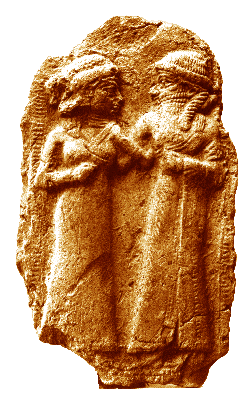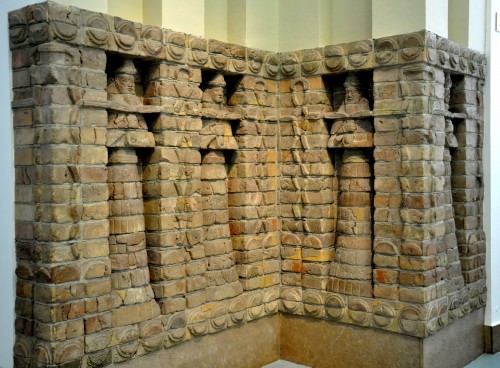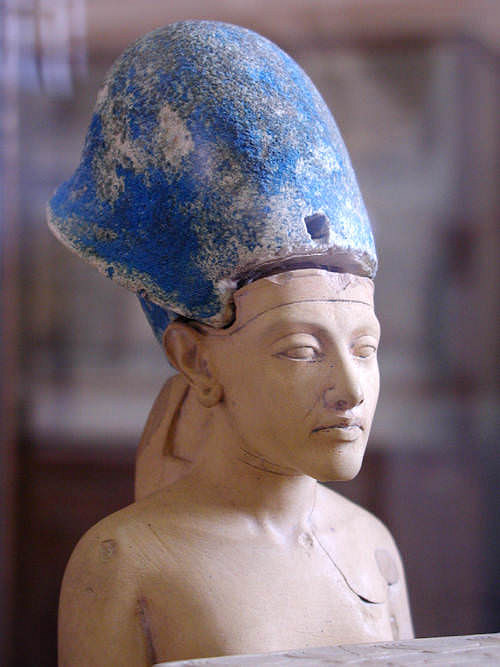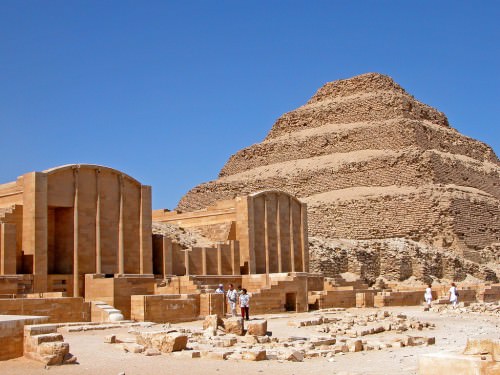Inanna › Pharaoh » Ancient origins
Articles and Definitions › Contents
- Inanna › Who Was
- Pharaoh › Antique Origins
Ancient civilizations › Historical and archaeological sites
Inanna › Who Was
Definition and Origins

Inanna is the ancient Sumerian goddess of love, sensuality, fertility, procreation, and also of war. She later became identified by the Akkadians and Assyrians as the goddess Ishtar, and further with the Hittite Sauska, the Phoenician Astarte and the Greek Aphrodite, among many others. She was also seen as the bright star of the morning and evening, Venus, and identified with the Roman goddess. Inanna is one of the candidates cited as the subject of the Burney Relief (better known as The Queen of the Night), a terracotta relief dating from the reign of Hammurabi of Babylon (1792-1750 BCE) although her sister Ereshkigal is the goddess most likely depicted.
In some myths she is the daughter of Enki, the god of wisdom, fresh water, magic and a number of other elements and aspects of life, while in others she appears as the daughter of Nanna, god of the moon and wisdom. As the daughter of Nanna, she was the twin sister of the sun god Utu/ Shamash. Her power and provocation is almost always a defining characteristic in any of the tales told of her.
INANNA IN MYTH
Through the work of the Akkadian poet and high priestess Enheduanna (2285-2250 BCE), daughter of Sargon of Akkad(2334-2279 BCE), Inanna was notably identified with Ishtar and rose in prominence from a local vegetative deity of the Sumerian people to the Queen of Heaven and the most popular goddess in all of Mesopotamia. The historian Gwendoly Leick writes:
Inanna was the foremost Sumerian goddess, patron deity of Uruk. Her name was written with a sign that represents a reed stalk tied into a loop at the top. This appears in the very earliest written texts from the mid-fourth millenium BC She is also mentioned in all the early god lists among the four main deities, along with Anu, Enki, and Enlil. In the royal inscriptions of the early Dynastic Period, Inanna is often invoked as the special protectress of kings. Sargon of Akkad claimed her support in battle and politics. It appears that it was during the third millenium that the goddess acquired martial aspects that may derive from a syncretism with the Semitic deity Ishtar. Inanna's main sanctuary was the Eanna (`House of Heaven') at Uruk, although she had temples or chapels in most cities. (89)
THE GODDESS APPEARS IN ANCIENT MESOPOTAMIAN MYTHS IN WHICH SHE BRINGS KNOWLEDGE AND CULTURE TO THE CITY OF URUK.
The goddess appears in many ancient Mesopotamian myths, most notably Inanna and the Huluppu-Tree (an early creation myth), Inanna and the God of Wisdom (in which she brings knowledge and culture to the city of Uruk after receiving the gifts from the god of wisdom, Enki, while he is drunk), The Courtship of Inanna and Dumuzi (the tale of Inanna's marriage to the vegetation-god), and the best known poem The Descent of Inanna (c. 1900-1600 BCE) in which the Queen of Heaven journeys to the underworld.
Besides these works and short hymns to Inanna, she is also known through the longer, more intricate hymns written by Enheduanna in honor of her personal goddess and the patroness of Uruk: Inninsagurra, Ninmesarra, and Inninmehusa, which translate as 'The Great-Hearted Mistress', The Exaltation of Inanna', and 'Goddess of the Fearsome Powers', all three powerful hymns which influenced generations of Mesopotamians in their understanding of the goddess and elevated her status from a local to a supreme deity. Her personal ambition is attested to in a number of the works which feature her. Dr. Jeremy Black writes:
Violent and lusting after power, she stands beside her favourite kings as they fight. In a Sumerian poem, Inanna campaigns against Mount Egih. Her journey to Eridu to obtain the meh and her descent to the underworld are both described as intended to extend her power. (108)
This ambition can also be seen through her manipulation of Gilgamesh in the tale of the Huluppu Tree: when she cannot handle the problem of the pests which infest the tree, and fails to find help from her brother Utu/Shamash, she attracts the attention of Gilgamesh who takes care of the situation for her. Still, her intentions in this story are true. She only wants to cultivate the tree in order to harvest the wood and cannot handle the serious and threatening pests which make it their home.Her gift of the sacred drum and drum sticks to Gilgamesh for helping her eventually result in Enkidu's journey to the underworld to retrieve them and the fascinating revelations his spirit brings back to Gilgamesh.

Facade of Inanna's Temple at Uruk
In the famous Sumerian/Babylonian poem The Epic of Gilgamesh (c. 2700 - 1400 BCE) Inanna appears as Ishtar and, in Phoenician mythology, as Astarte. In the Greek myth The Judgment of Paris, but also in other tales of the ancient Greeks, the goddess Aphrodite is traditionally associated with Inanna through her great beauty and sensuality. Inanna is always depicted as a young woman, never as mother or faithful wife, who is fully aware of her feminine power and confronts life boldly without fear of how she will be perceived by others, especially by men.
In The Epic of Gilgamesh, as Ishtar, she is seen as promiscuous, jealous, and spiteful. When she tries to seduce Gilgamesh, he lists her many other lovers who have all met with bad ends at her hands. Enraged at his rejection, she sends the husband of her sister Ereshkigal, Gugulana (the Bull of Heaven) to destroy Gilgamesh's realm. Gugulana is then killed by Enkidu, the best friend and comrade-in-arms of Gilgamesh, for which he is condemned by the gods to die. Enkidu's death is the catalyst for the famous quest Gilgamesh undertakes to discover the meaning of life. Inanna, then, is central to the story of one of the greatest of ancient epics.
ASPECTS OF THE GODDESS
She is often shown in the company of a lion, denoting courage, and sometimes even riding the lion as a sign of her supremacy over the 'king of beasts'. In her aspect as goddess of war, Inanna is depicted in the armor of a male, in battle dress (statues frequently show her armed with a quiver and bow) and so is also identified with the Greek goddess Athena Nike. She has been further associated with the goddess Demeter as a fertility deity, and with Persephone as a dying-and-reviving god figure, no doubt a carry-over from her original incarnation as a rural goddess of agriculture.
Although some writers have claimed otherwise, Inanna was never seen as a Mother Goddess in the way that other deities, such as Ninhursag, were. Dr. Jeremy Black notes:
One aspect of [Inanna's personality] is that of a goddess of love and sexual behaviour, but especially connected with extra-marital sex and - in a way which has not been fully researched - with prostitution. Inanna is not a goddess of marriage, nor is she a mother goddess. The so-called Sacred Marriage in which she participates carries no overtones of moral implication for human marriages. (108)
Rather, Inanna is an independent woman who does as she pleases, quite often without regard for consequences, and either manipulates, threatens, or tries to seduce others to fix the difficulties her behaviour creates. There are no poems, tales, or legends which in any way portray her differently and none which depict her in the role of the Mother Goddess.

The Hand of Ishtar (Inanna)
In the Mesopotamian pantheon Inanna's geneology varies with the era of the myth and the tale told. She is the daughter of the supreme god Anu but also is depicted as the daughter of the moon-god Nanna and his consort Ningal. Alternately, she is the daughter of the god of wisdom Enki and sister to Ereshkigal (goddess of the underworld), twin sister of the sun god Utu/Shamash, and sister of Ishkur (also known as Adad), god of storms. She is also sometimes referenced as the daughter of the Supreme God of the Air, Enlil.
Her husband Dumuzi - who suffers for her rash choices in the poem The Descent of Inanna - transforms in time into the dying-and-reviving god Tammuz and, annually at the autumn equinox, the people would celebrate the sacred marriage rites of Inanna and Dumuzi (Ishtar and Tammuz) as he returned from the underworld to mate again with her, thus bringing the land to life. The Sacred Marriage of Inanna and Dumuzi was central to the fertility of the land and was re-enacted at important festivals (such as the Akitu Festival at Babylon) by the king and a priestess having sexual intercourse or, perhaps, only symbolically mating in a kind of pantomime.
Her temple at Uruk was her central cult center but throughout Mesopotamia her temples and shrines were numerous and sacred prostitutes, of both genders, may have been employed to ensure the fertility of the earth and the continued prosperity of the communities. Inanna continued as a powerful and popular goddess until the decline of the prestige of female deities during the reign of Hammurabi which, according to scholar Samuel Noah Kramer, coincides with women's loss of status and rights in society. Still, as Ishtar of the Assyrians, she continued to be widely venerated and inspired the visions of similar deities in other cultures of the Near East and beyond.
THE ENDURING GODDESS
Inanna is among the oldest deities whose names are recorded in ancient Sumer. She is listed among the earliest seven divine powers: Anu, Enlil, Enki, Ninhursag, Nanna, Utu, and Inanna. These seven would form the basis for many of the characteristics of the gods who followed. In the case of Inanna, as noted above, she would inspire similar deities in many other cultures.
A vastly different personality from that of the traditional Mother Goddess (as exemplified in Ninhursag), Inanna is a brash, independant young woman; impulsive and yet calculating, kind and at the same time careless with other's feelings or property or even their lives. Jeremy Black writes:
The fact that in no tradition does Inanna have a permanent male spouse is closely linked to her role as the goddess of sexual love. Even Dumuzi, who is often described as her `lover', has a very ambiguous relationship with her and she is ultimately responsible for his death. (108)
The fact that the Sumerians could conceive of such a goddess speaks to their cultural value and understanding of femininity.In Sumerian culture women were regarded as equals and even a cursory survey of their pantheon shows a number of significant female deities such as Gula, Ninhursag, Nisaba, and Ninkasi, among many others. In time, however, these goddesses lost status to male deities. Under the reign of the Amorite king Hammurabi of Babylon (1792-1750 BCE) goddesses were increasingly replaced by gods. Inanna kept her position and prestige through her adoption by the Assyrian and Neo-Assyrian empire as Ishtar, goddess of war and sex, but many others did not fare so well. Nisaba, formerly the scribe of the gods and patroness of the written word, was assimilated into the god Nabu under Hammurabi's reign and this was the fate of many others.
Inanna endured, however, because she was so accessible and recognizable. Women and men both could relate to this goddess and it was no coincidence that both sexes served her as priests, temple servants, and sacred prostitutes. Inanna made people want to serve her because of who she was, not what she had to offer, and her devotees remained faithful to her long after worship in her temples had ceased. She was closely associated with the morning and evening star and, even the present day, she continues to be - even if few remember her name.
Pharaoh › Antique Origins
Definition and Origins

The Pharaoh in ancient Egypt was the political and religious leader of the people and held the titles 'Lord of the Two Lands' and 'High Priest of Every Temple '. The word 'pharaoh' is the Greek form of the Egyptian pero or per-aa, which was the designation for the royal residence and means `Great House'. The name of the residence became associated with the ruler and, in time, was used exclusively for the leader of the people.
The early monarchs of Egypt were not known as pharaohs but as kings. The honorific title of `pharaoh' for a ruler did not appear until the period known as the New Kingdom (c.1570-c.1069 BCE). Monarchs of the dynasties before the New Kingdom were addressed as `your majesty' by foreign dignitaries and members of the court and as `brother' by foreign rulers;both practices would continue after the king of Egypt came to be known as a pharaoh.
THE KINGSHIP IS ESTABLISHED
In 3150 BCE the First Dynasty appeared in Egypt with the unification of Upper and Lower Egypt by the king Menes (c. 3150 BCE, now believed to be Narmer ). Menes/Narmer is depicted on inscriptions wearing the two crowns of Egypt, signifying unification, and his reign was thought to be in accordance with the will of the gods; but the office of the king itself was not associated with the divine until later.
During the Second Dynasty of Egypt (2890-2670 BCE) King Raneb (also known as Nebra) linked his name with the divine and his reign with the will of the gods. Following Raneb, the rulers of the later dynasties were equated with the gods and with the duties and obligations due to those gods. Chief among these was the maintenance of ma'at - harmony and balance - which had been decreed by the gods and needed to be observed in order for people to live the best possible life.
Osiris was considered the first "king" of Egypt and so earthly rulers honored him, and established their own authority, by carrying the crook and the flail. The crook stood for kingship (guidance of the people) while the flail was associated with the fertility of the land (threshing wheat). The crook and flail were associated with an early powerful god named Andjety who came to be absorbed by Osiris. Once Osiris was established in tradition as the first king, he son Horus also came to associated with a pharaoh's reign.
The cylindrical objects sometimes seen in the hands of statues of Egyptian monarchs are known as the Cylinders of Pharaoh and the Rods of Horus and are thought to have been used to focus one's spiritual and intellectual energy - much in the way someone today might use Rosary Beads or Komboloi (worry beads).
THE PHARAOH WAS CONSIDERED A GOD ON EARTH, THE INTERMEDIARY BETWEEN THE GODS & THE PEOPLE.
As supreme ruler of the people, the pharaoh was considered a god on earth, the intermediary between the gods and the people. When the pharaoh came to the throne he was instantly associated with Horus - the god who had defeated the forces of chaos and restored order - and when he died, he was associated with Osiris, the god of the dead.
As such, in his role of 'High Priest of Every Temple', it was the pharaoh's duty to build great temples and monuments celebrating his own achievements and paying homage to the gods of the land who gave him the power to rule in this life and would guide him in the next.
Additionally, the pharaoh would officiate at religious ceremonies, choose the sites of temples and decree what work would be done (although he could not choose priests and very rarely took part in the design of a temple). As 'Lord of the Two Lands' the pharaoh made the laws, owned all the land in Egypt, collected taxes, and made war or defended the country against aggression.

Narmer
The rulers of Egypt were usually the sons or declared heirs of the preceding pharaoh, born of the Great Wife (pharaoh's chief consort) or sometimes a lesser-ranked wife whom the pharaoh favored. Early on, the rulers married female aristocrats in an effort to establish the legitimacy of their dynasty by linking it to the upper classes of Memphis, which was then Egypt's capital.
This practice may have begun with Narmer, who established Memphis as his capital and married the princess Neithhotep of the older city of Naqada to consolidate his rule and link his new city to Naqada and his home city of Thinis. To keep the blood-line pure, many pharaohs married their sisters or half-sisters and Pharaoh Akhenaten married his own daughters.
THE PHARAOH AND MA'AT
THE PHARAOH HAD A SACRED DUTY TO DEFEND THE BORDERS OF THE LAND, BUT ALSO TO ATTACK NEIGHBORING COUNTRIES FOR NATURAL RESOURCES.
The chief responsibility of the pharaoh was to maintain ma'at throughout the land. The goddess Ma'at (pronounced 'may-et' or 'my-eht') was thought to provide harmony through the pharaoh but it was up to the individual ruler to interpret the goddess' will correctly and to then act on it.
Accordingly, warfare was an essential aspect of the rule of pharaoh, especially when it was seen as necessary for the restoration of balance and harmony in the land. This concept of war is exemplified in The Poem of Pentaur, written by the scribes of Rameses II, the Great (1279-1213 BCE), regarding his victory over the Hittites at the Battle of Kadesh in 1274 BCE.
The Hittites, according to Ramesses II, had disrupted the balance of Egypt and so needed to be dealt with severely. The pharaoh had a sacred duty to defend the borders of the land, but also to attack neighboring countries for natural resources if it was thought that this was in the interest of harmony.
PHARAOHS AND THE PYRAMIDS
By the 3rd dynasty King Djoser (c. 2670 BCE) commanded enough wealth, prestige and resources to have the Step Pyramidbuilt as his eternal home. Designed by the vizier Imhotep (c. 2667-2600 BCE), the Step Pyramid was the tallest structure of its day and a very popular tourist attraction then, as it is today. The pyramid was designed primarily as Djoser's final resting place but the splendor of the surrounding complex and great height of the pyramid were intended to honor not only Djoser but Egypt itself and the prosperity of the land under his reign.
Other 3rd Dynasty kings such as Sekhemkhet and Khaba built pyramids following Imhotep's design (the Buried Pyramid and the Layer Pyramid) and created a type of monument which would become synonymous with Egypt even though the pyramid structure was used by many other cultures (notably the Maya, who had no contact at all with ancient Egypt). Old Kingdommonarchs (c. 2613-2181 BCE) then followed suit culminating in the Great Pyramid at Giza, immortalizing Khufu (2589-2566 BCE) and making manifest the power and divine rule of the pharaoh in Egypt.

Step Pyramid Complex at Saqqara
THE 18TH DYNASTY AND EGYPT'S EMPIRE
With the collapse of the Middle Kingdom in 1782 BCE, Egypt came to be ruled by the mysterious Semitic people known as the Hyksos. The Hyksos, however, emulated all the trappings of the Egyptian pharaohs and kept the customs alive until their kingdom was overthrown by the royal line of the Egyptian 18th Dynasty which then gave rise to some of the most famous of the pharaohs such as Rameses the Great and Amenhotep III (r.1386-1353 BCE).
This was the period of Egypt's empire and the prestige of the pharaoh was never greater. Egypt controlled the resources of regions from Mesopotamia down through the Levant, across to Libya, and further south into the Nubian Kingdom of Kush.When Ahmose I (c.1570-1544 BCE) drove the Hyksos from Egypt, he established buffer zones around the borders so that no other invasive people could gain a foothold inside Egypt. These zones were eventually fortified and goverened by Egyptian administrators who would report to the pharaoh.
These pharaohs were predominantly male but Queen Hatshepsut (1479-1458 BCE) of the 18th Dynasty ruled successfully as a female monarch for over twenty years and, during her reign, Egypt prospered. She re-established trade with the Land of Punt and encouraged trade expeditions elsewhere which caused the economy to boom. Hatshepsut was responsible for more public works projects than any pharaoh save Rameses II and her rule is marked by peace and affluence throughout the land.
When Tuthmose III (1458-1425 BCE) came to power after her, he had her image removed from all her temples and monuments in an effort, it is thought, to restore order to the land. According to tradition, a woman should never have held the title of the pharaoh - that was an honor reserved for males in keeping with Osiris as the first king of Egypt and his sister Isis as his consort, not reigning monarch. It is thought, then, that Thutmose III feared Hatshepsut's example might inspire other women to 'forget their place' in the sacred order and aspire to power the gods had reserved for males.
DECLINE OF THE PHARAOH
The New Kingdom was the period of Egypt's greatest success on many levels but it could not last. The power of the pharaoh began to decline after the reign of Ramesses III (r.1186-1155 BCE) during which the Sea Peoples had invaded. The cost of the Egyptian victory over the Sea Peoples, both financial and in lives lost, was considerable and Egypt's economy began to decline.
The first labor strike in history also occurred under Ramesses III which called into question this pharaoh's ability to maintain ma'at and how much the upper classes actually cared for the people. A number of other factors also contributed to the end of the New Kingdom that ushered in the Third Intermediate Period (c. 1069-525 BCE) which concluded with the Persian invasion.
The prestige of the pharaoh waned considerably after the defeat of the Egyptians by the Persians at the Battle of Pelusium in 525 BCE and, still further, after the conquests of Alexander the Great. By the time of the last pharaoh, the well-known Cleopatra VII Philopator (c. 69-30 BCE) of the Ptolemaic Dynasty, the title no longer held the power it once did, fewer monuments were erected and, with her death in 30 BCE, Egypt became a Roman province and the glory and might of the pharaohs of old faded into memory.
LICENSE:
Article based on information obtained from these sources:with permission from the Website Ancient History Encyclopedia
Content is available under License Creative Commons: Attribution-NonCommercial-ShareAlike 3.0 Unported. CC-BY-NC-SA License